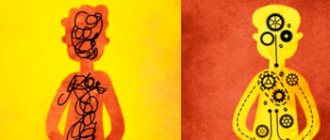Template thinking
Welcome to my blog, friends. I want to dedicate this entry to such a concept as template thinking. Have you ever thought that we all live by rules every day? Society, education, moral and ethical standards at the subconscious level have embedded behavioral scripts in us. Today we’ll talk about how this affects our lives.
“Everything significant that has been created in human history is the fruit of the individual creativity of a genius. The masses can only repeat” Gabriel Tarde.
According to their way of thinking, people are divided into two types. Those who think in stereotypes, and those whose way of consciousness is outside the stereotypes. There are many more of the first, because at all times logic has been the most important of truths. No one took into account situations where the logical solution was not the only one.
Let me give you a trivial example - children's blocks. A child assembles a pyramid of cubes, stacking them on top of each other - this is pattern thinking. His parents push him to this action. But if a child arranges cubes, drawing a pattern out of them, or simply scatters them chaotically, this is thinking outside the framework of patterns. At the same time, perhaps this pattern that the baby laid out can be useful to exactly the same extent as if a pyramid was built from cubes.
Two steps forward, four steps back... - don’t even try to step aside!
“A man must do three things in life - plant a tree, build a house and give birth to a son” - have you heard this saying? This is nothing more than a real template.
An unmarried woman is unhappy, a person who does not have a decent bank account is a loser, what time should you get up and go to bed, what and how to eat, when to give birth to children and how to raise them - there are plenty of examples of templates.
From the very first day of a person's life, he is assigned a pattern, and the older he gets, the wider the range of patterns by which he must live. What's wrong with that, you ask? Nothing!
A template is nothing more than life experience accumulated over many generations. A person, taking advantage of mistakes already made by someone else in a variety of situations, knows the result of his action before he commits it.
If you touch a fire, you can get burned, if you eat poorly, you will have health problems, and if you don’t go to work, you risk being fired. There must be rules in society! Otherwise there will be chaos.
But! The scale of the pattern of our life is so great that the framework has penetrated into every area of it. We are used to it and it is convenient for us. But! Often the ability to think only in patterns prevents us from seeing more than we see. Stereotypical thinking prevents us from making truly necessary decisions.
Recommendations for Maximizing the Results of Thinking Outside the Box
Going beyond standard thinking should be quick, but at the same time anticipate future events. Try to start thinking unconventionally not only when solving current problems, but also when thinking about how you want to see your future. Work on the system as a whole, don't limit yourself to just its contents.
Your thinking should be able to cover the entire breadth of your goals. When choosing a subject for your thoughts, you do not need to limit yourself to any boundaries
For example, when solving a cost problem, pay attention to sales too. If you have no idea where you are going, you could end up anywhere
But if you clearly know where you must go, then you will not open new horizons.
Try to think outside the box in all areas of your life. If you want to make a qualitative breakthrough in your thinking, act within the widest possible boundaries. Focus not only on solving the problem, but also on ways to prevent it in the future.
Encourage holders of tacit knowledge to overcome the framework of standard thinking. Qualitative breakthrough is possible only when deep knowledge is combined with creative, out-of-the-box thinking. Knowledge in itself is valuable, as is out-of-the-box thinking. But when one is supported by the other, the chances of success increase significantly.
Identify and become aware of the boundaries that prevent you from going beyond your usual limits. In every area in which you have to look for ways to solve problems, identify the boundaries that limit you. Be specific about them, perhaps even in writing. And then think about whether it’s worth sticking to them or whether you’re capable of more.
Stop thinking mechanically. When a company constantly adheres to the same rules, without making any adjustments or changes, repeating the same truths and postulates, employees develop mechanical thinking. To empower employees to think outside the box and focus on goals, remove some of the boundaries that limit them.
When achieving each new goal, do not focus on your past success. Many who have achieved success probably have their own set of rules and laws, thanks to which they achieved this success. And trying to achieve new heights, out of habit they continue to adhere to the same rules. Break down those boundaries that are stopping you from discovering new horizons.
Reduce the risk of unconventional thinking. Every unconventional idea should have minimal risk. Use the “carrot and stick” method, where the carrot should go to those who think outside the box, and the stick to those who do not want to go beyond the usual boundaries.
Build a strong foundation. Every new idea that comes into your head is a combination of several ideas, at least two. If the final idea is divided into parts, they will be something like “semi-finished” finished ideas. Use them as the foundation for creating your own breakthrough.
Adhere to the principle “morning is wiser than evening.” Don’t think that brilliant ideas should come to you instantly. By allowing yourself to think carefully about a problem, your ideas for solving it will be much more effective. We often say and hear phrases such as “I need to think about this,” “I need to digest this,” “let’s come back to this a little later.” Approach solving problems consciously; rushing in this matter will not lead to success.
Are you already a computer or not yet?
The most accurate method of template thinking is a computer. The program embedded in the “brain” of the computer processes information and responds to it, strictly according to approved directives. A person’s adaptability to norms, the habit of thinking in scripts, leads to the fact that he, at the subconscious level, rejects everything that is outside the template, outside the program. This is how human psychology works - to go to what is most convenient.
Meanwhile, life confronts us with different tasks, and sometimes the only correct solution is outside the framework of the template.
But we don’t see this solution, because it is behind the limitations that our own subconscious sets for us. Hence failures, lack of ideas, and, as a result, loss of interest. It’s good if it’s about a specific issue, bad if it’s about life. A stereotyped personality is very often in a struggle with his own inner world. Because natural desires are replaced by a subconscious desire to conform to the framework. Think bigger!
Status quo
This term refers to the situation before an event occurs. Simply put, this is the original state of affairs. The thinking trap called “status quo bias” prevents us from committing to change. This is why we continue to work in the wrong jobs, be in the wrong relationships, etc. We are accustomed to a certain algorithm of actions (and some for our whole lives!), even if we don’t really like it. But we are so afraid of change that we are ready to endure it. After all, changes require us to rebuild, adapt to new conditions, and morally and physically. Here everyone makes a decision for themselves - to come to terms with the current situation, closing off further prospects for themselves, or to overcome themselves and make a little effort to reach a new level of life.
Discover your genius
Creativity is the most striking example of non-standard thinking. And not only in art. Chemistry, physics, rational theories, whatever - our everyday life, from everyday problems to professional ones - everywhere there is a place for creativity.
Think for yourself - if all of humanity lived only according to patterns, then we would not have geniuses and their great inventions. We would not know the great artist Leonardo Da Vinci, the legendary physicist Albert Einstein, one of the best composers in the world Wolfgang Mozart and all the others who gave humanity development in various areas of life. In many ways, the secret of the enormous scale of their talent is also in the ability to think broader than everyone else. One hundred percent originality.
What prevents us from going beyond our usual thinking?
There are three main obstacles that prevent us from breaking out of the boundaries of our standard thinking:
Barrier No. 1
. Previously, for many, the breadth of thinking was associated with some crazy ideas, the implementation of which did not bring anything useful or good into our lives. Below we will look at several recommendations that are aimed at those areas where, by concentrating on them, we can make a qualitative leap in our thinking.
Barrier No. 2
. Due to the fact that we receive payment for our work precisely for certain actions, and not for our thoughts, many people are not inclined to spend extra time on abstract thoughts. And it is precisely this obstacle that is one of the most “slowing down” us in going beyond stereotyped thinking.
Barrier No. 3
. If you decide to apply a non-standard solution to a problem in your work environment, you are always taking a certain risk. And since in many companies the rewards for such decisions and the risk to which you expose yourself are unfavorably correlated, many people prefer to stick to familiar ways of solving problems.
What about you and me?
Let there be frameworks, I wrote above - you can’t do without them. But it is important to be able to open your own eyes where the situation seems hopeless, and the absolutely correct and logical solution does not seem to fit. And this can be learned.
Today, in the age of information technology, the availability of almost any information is very convenient. The Internet is crammed with all kinds of advice that help you get rid of boundaries and expand your own consciousness.
Everyone decides what to read or watch, but I can advise you to read a wonderful book that can teach you to see and act beyond the boundaries.
Brian Tracy's book "Get Out of Your Comfort Zone" Change your life. 21 methods for increasing personal effectiveness."
Brian Tracy is the author of many acclaimed self-development books. Among his favorite topics are business and personal development, cultivating leadership qualities. He is recognized as one of the best consultants in the world.
Recommendations
Working on self-esteem
This will help you become more resilient so as not to fall into a sacrificial position.
It is not necessary to show willpower and so on, it is important to accept yourself as you are. Study your character traits and not demand the impossible
The people around you are interesting because they are different. Creative people seem unique and special. But our only difference with them is that they let go of control and allowed themselves to be natural, despite the condemnation and opinions of others.
Focusing on yourself and your desires is very important. Because no one will live your life except you. Therefore, you should work where you like, even if it does not coincide with the expectations of your wife or parents. Rest in such a way as to restore resources and have fun, and not maintain the status of a person with an active position, for example, and drive yourself to parties, trainings, exhibitions, etc. every weekend.
And in order to allow you to be who you are, the first thing you should do is love yourself. Then you will quickly find a place in the sun. If you don't know where to start, you can read the article located here.
Restrictions
Have you seen the movie “Always Say Yes” with Jimmy Carrey? The main character decided to change something in his life, because depression and routine consumed him so much that nothing made him happy at all. He simply stopped refusing, no matter what offers he received. And believe it or not, he not only managed to bring drive, but also achieve success.
We don’t recommend doing so radically, you never know what comes into anyone’s head. But it’s worth forgetting about phrases like “I can’t do it,” “I can’t do this,” “it’s pointless.” After all, the main principle of non-standardism is to act not as usual, but in a new way. Human psychology is such that he is capable of doing the impossible if only he believes that everything will work out for him. Any restrictions are only in our head.
Horizon
Remember what you were like as a child? Yes, children are different, but most love to experiment, because how else can they explore the world, besides asking endless questions to their parents? It was for this reason that someone took apart radios, cars, dolls and teddy bears. To find out how everything works there. Then, as we grow up, we slow down the impulses of curiosity, even in those places where it is required.
If you don’t want to learn something new or take up a hobby, you can simply go to a restaurant that you haven’t visited before. Take a walk through an unfamiliar area, if it is not possible to at least go on an excursion to the neighboring region. As a last resort, just change your usual route to work. Your brain is instantly activated, and this is exactly what is needed to change your thinking style even slightly.
Expand your horizons, so you will always be on your toes. Agree, it’s not difficult to devote 5 minutes a day to learning something new, right? Even if it’s just one foreign word. In a year, with this minimal regimen, you will be able to significantly expand your vocabulary.
Workout
Solve problems and puzzles that are aimed at developing the right hemisphere of the brain. It is responsible for our creative part of personality, speech and even intuition, the ability to “understand” people.
Listen to classical music, watch comedy shows, do yoga, after all. Sports and humor have a beneficial effect on our mental abilities and help change the type of thinking.
You will find examples of interesting and exciting tasks if you follow this link.
Advice
Be sure to train your brain, especially with non-standard tasks. In my opinion, this service is best to cope with this task. There you will find a lot of online simulators for developing your brain.
Consequences
Living in a blinkered state or being overly extravagant in making decisions is everyone’s business. But it’s still better to find a middle ground. Otherwise, it’s easy to bury talent in the ground – both your own and your child’s. And sometimes not only your own. How many teachers do not give the opportunity to create freely, how many act exclusively within the framework of methodological recommendations! As a result, Petya, who was the best student in the first grade, is no longer interested in anything by the end of the third. He is bored in class, he does not want or even cannot become like everyone else.
A similar thing can happen to a talented young employee who is trying to prove to more experienced colleagues that using an old computer program is irrational. When everyone, right down to management, asks him to mind his own business for the hundredth time, he will stop doing it. And he will either merge with the gray mass of his colleagues or find another job.
A wife who is trying to prove to her family that it is not at all necessary to clean every weekend, it is better to spend them outdoors (at the theater, museum, cinema), when faced with misunderstanding, she will either run away or become a housewife in the worst sense of the word. And then the probability that her husband will run away from her is very high. And then - stress, depression, alcohol and other troubles.
Examples
Broad conclusions about a person based on minimal information do not stand up to criticism. Examples of stereotypical thinking can be conclusions about intellectual level - this often applies to blondes (even a huge number of jokes) and athletes (often explained by inability to do something). Such conclusions are enshrined in the popular worldview and, as a result, even after numerous scientific refutations, continue to guide people.
Tourists acquire stereotypical knowledge of countries by seeing them only from a bus window, visiting famous places and listening to historical reports. The real country remains unexplored, because there are practically no locals in tourist places, the cuisine is adapted for Europeans, and everyday life is hidden by historical facades - this is what creates the feeling of the picture. This applies not only to countries, but also to entire nations - the Japanese are considered smart, Russians are careless, and gypsies are considered thieves. These are all examples of stereotypical thinking that relate to the nation, but have nothing to do with a specific person.
A woman freely dismantling a car on the highway causes either surprise or indignation; some may joke that she will break it, and all only because the stereotype of girls’ inability to drive is firmly established. Those who cannot earn enough money on their own consider the rich to be thieves and only because several bribe takers or criminals have been declassified. It is easier for a person to explain someone else’s success by unseemly behavior, and to somehow whitewash himself, than to accept responsibility and take a broader look at what the other did that he himself could not. This also includes the belief that a beautiful girl cannot be smart, and even if she has a PhD, then this is a purchased job, and her position is under the patronage of her lover. This is a vivid example of how the rational mind begins to serve the stereotypical mind, continuing to look for justifications and support for its concept, because otherwise something inside will collapse (excuses, self-image, habitual doing nothing) and a new one will fall in (responsibility, the task of thinking, admitting the impossible, learning other's).
Ways to overcome
Remember yourself as a child. What made you change your bright clothes to a gray suit? Who prevented you from becoming an artist? Why do you spend every evening alone? How did it happen that there was a hole in the wallet? Maybe the whole point is that at some point you stepped on the throat of your own song? Then it's time to regain your "I".
- Let's stop thinking like everyone else.
- You need to stop judging your every step from the “height” of the surrounding society.
- We change our social circle. There is no need to delete all your buddies and friends from your phone book. Better expand your boundaries. Take an English language course, for example, your studies develop you. And at the same time, new comrades will appear.
- We throw away all the books that prescribe what a real lady should do before the age of 25 or describe the rules of life for a true gentleman.
- Expanding our horizons. Throw away the rags, buckets, hammers, shovels, rakes on the weekend and go to the theater. And look at others, and you will show yourself, which means you will have to put your appearance in order.
How to get rid of stereotypical thinking
Getting rid of stereotypes begins with the realization that no one’s opinion can be exclusively correct and become the truth for your worldview. Even those truths that some time ago were undeniable for everyone are being revised, scientific discoveries show the inconsistency of knowledge and open up new points of view. It is necessary to constantly keep this in mind and question every spoken fact, especially those that are presented without argumentation, but emotionally.
Study the opinions of other people, from different specialties and areas; do not re-read the same works and argue with others. You can get rid of stereotypical thinking if you listen to the point of view of others, ask questions, discuss everything that happens around you. There is no need to raise global philosophical topics or scientific achievements in simple conversations - just discuss a film or a new book and then the world of another person will open up, noticing what eludes you. Everyone is subject to stereotypes, only when faced with strangers do we get the opportunity to destroy our own stereotypical thinking.
The desire to learn new things destroys stereotypical thinking. This may be travel, not necessarily abroad, introducing you to other people’s cultures and new ways of reacting. Visits to the exhibition open up horizons for the manifestation of one’s creativity; new books raise new socio-psychological questions. The more time is spent on arranging the space for receiving new information, the more likely it is that there will be no room left for stereotypical thinking. People who prefer the same cafe fall into the category where it is tasty only there, while those who set themselves the goal of trying all the dishes in different places admit that they can cook it with different shades.
Choose your social circle, getting rid of those who simply impose their opinions on you and, on the contrary, communicate more often with those who ask questions and lead discussions. The more a person himself is influenced by stereotypes, the higher the likelihood that he will forcefully draw you into this circle, and those who seek the truth and strive to constantly be surprised by the new will develop this in you too.
Do not believe either gossip or stories about others - if the information does not allow you to live in peace, then it is better to double-check it directly than to support the opinion of another person and his conclusions. Another excellent practice is to look for your own stereotyping, when your global judgments (usually looking like everyone is bad or smart, someone is beautiful, and someone is stupid) often occurs. Find out where you personally have such confidence, and it may turn out that this is what your relatives said or this was what was accepted in the society of your childhood. Arrange practical experiments and check how these beliefs really work, perhaps you will even be convinced of their validity, but most likely some will fall away, bringing the development of the skill of critical judgment.
battle of Borodino
From official history we know that on June 24, 1812, Napoleon, leaving Warsaw with his six hundred thousand army, invaded Russian territory. Instead of going to the capital St. Petersburg, Napoleon's troops went to Moscow. In the twentieth of August, 135,000 Napoleonic soldiers (according to the average estimate of dozens of different “researchers” from many countries), not counting the 1,500-strong cavalry corps and about 15,000 non-combatants (support personnel) found themselves near Borodino.
Could this happen?
Answering this question, let us remember that according to official history, in 1812 there were no railways in Russia, and there was no road or air transport. All transportation of goods, including by the French army, was carried out on carts drawn by horses.
Let's simplify Napoleon's problem to the limit . To do this, let’s assume that there was a straight, flat, three-lane, safe road from Warsaw to Borodino. Only those who participated in the battle and the convoy necessary to support them walked along it. The remaining ¾ of the army went somewhere in a roundabout way. Along the entire road to Borodino there were abundant pastures, sufficient for tens of thousands of horses, used between transitions. After all, horses capable of carrying 600 kg each would not have enough food for the entire journey, even one way, if they carried only it and only for themselves, and they also had to carry food for the soldiers, ammunition, tents and other equipment. Along the road, in the right places, there were reservoirs for watering and bathing horses, as well as sources of drinking water for people, at least in a volume of 300,000 liters/day. There were also no problems with areas for instantly organizing halts and overnight stays.
At least three lanes of the road are needed so that a column of infantry and horses, pulling cannons and carrying ammunition, move along one, cavalry and a convoy with non-combatants move along the second, and horses with freed carts return along the third.
The length of the column of soldiers, four in a row, and the depth of each row is one meter - 135,000/4 = 33.75 km. Let's add to it teams with 587 guns and at least one cart with ammunition for each, that is, 1174 teams with a norm of 10 m in length for each. This is another 11.74 km. The total length of the continuous column “to Borodino” is 45.5 km. She didn’t have any hitches or problems along the way; the whole movement went perfectly. All the people and horses were healthy, well-fed, watered and full of strength.
The distance between Warsaw and Borodino is about 1200 km. Let us assume that Napoleon was able to repeat every day the army speed record he achieved (according to official historians) in the Ulm maneuver in 1805, 25 km/day. That is, it would have taken him only 48 days from the moment the column completely left. He managed to arrive in Borodino by August 24 with a reserve. And this is taking into account the fact that the rearguard of the column left Warsaw only at the end of the second day from the start of the campaign.
What happened on the Borodino field
As official historians say, having gathered at the site of the impending battle, the Russian and Napoleonic armies positioned themselves as shown on this “map”:
To further simplify the tasks of Kutuzov and Napoleon, we will assume that the Kolocha River and its tributary are inconspicuous streams that do not interfere with the military advance of troops. In addition, despite the close proximity of the troops (the distance between them was about two lengths of Red Square in Moscow), the opponents did not interfere with each other in building redoubts and flushes for the placement of artillery. The local skirmish on the eve of the main battle was conventionally “reconnaissance in force.”
And now, the morning of the battle. Troops at their starting positions in battle formation. In total there are about 265,000 people, not counting another 30,000+ non-combatants/militia and cavalry on both sides. The combat formation differs from the stationary one in that the intervals between the rows are greater, so that the soldiers can take weapons, extended by bayonets, at the ready, without injuring those standing in front of them.
The guns are positioned and loaded. There are so many of them (587 versus 640) that, being evenly distributed along the entire front line, without squeezing redoubts, flashes, batteries into the frames, between the centers of their muzzles the French would have approximately 5.6 m, and the Russian army only 5, 15m. That is, artillery crews would literally stand shoulder to shoulder, and not “on top of each other” within batteries, redoubts, and flushes.
The size of the field on which they will face is approximately 10x10 of Moscow's Red Square in its current form. To imagine the picture “before the battle”, take a look at the photograph of the location of a stationary, relatively compact, formation of 13,000 people (1/20 troops in Borodino) at the Victory Parade on 05/09/2019.
If a battle had taken place under such conditions, then after the first volley of grapeshot from all the guns on each side, the first rows of the formations of both armies would have been almost completely mowed down. The following ranks, marching almost shoulder to shoulder with their neighbors in ranks, would have to walk over the bodies of the killed and wounded from the previous ranks. They would not have had the space or time to go around those lying and sitting. A few more friendly volleys of artillery that did not have time to come into contact with the enemy would have littered the entire space that was between them before the shooting began with the bodies of the killed and wounded.
If we imagine that the troops did come into contact, then the artillery would become useless, since the shells would fly towards their own. Less than half an hour would have passed (this is with a large margin) before both armies would have suffered unacceptable losses, and the battle would have stopped. There could be no talk of any twelve hours of battle, as stated by official history. Although, if Napoleon, Kutuzov and their generals were inveterate butchers and used reserves as barrage detachments, then perhaps the mess would have continued for some time. But even historians who take an official position do not talk about such characteristics of military leaders.
***
Additional confirmation of the fabulousness, and not the reality, of the Battle of Borodino can be considered:
- The extreme complexity of solving the logistics and organizational problems of the Napoleonic army for arriving in Borodino even in the idealized simplified conditions described above.
- The strangeness of death, embalming and the leisurely and adventurous burial of each in parts: Kutuzov, Barclay de Tolly, Napoleon and, perhaps, some of the other military leaders who were allegedly there.
- Negative attitude of L.N. Tolstoy to his novel “War and Peace”, who visited Borodino while writing the book, and refused to award the Nobel Prize for it.
- There are no traces of battle on the Borodino Field.
- The list goes on for a long time. Let's stop there.
***
This example of breaking a thought pattern was chosen because of its simplicity, due to the large number of details invented by historians. Details, the far-fetchedness of which lies on the surface. Pick a little and they fall apart.
Not only the Battle of Borodino was invented. Almost the entire world history, which seems so harmonious and consistent to us, has been distorted. This worldwide fictional history project is brilliant. A huge amount of systematic work has been done within its framework. But it was performed by people whose knowledge was also limited. They could not take into account and agree on all the nuances and details. Therefore, for those who are not lazy to check what they heard/read and have knowledge that the authors of specific historical tales lacked, it is relatively easy to identify lies by asking the question: “What must be true for what they saw/read/heard to be true?”
The cognition technique is described in more detail in the article “ The easiest way to effective cognition .”
Development
Cognitive thinking develops with the help of inner speech, therefore, the thought process depends on language. Language and thought are inseparable. They must be trained daily, otherwise it is difficult to achieve good results.
This type of thinking is well developed:
- games of checkers, chess, backgammon, poker;
- assembling puzzles, Rubik's cube;
- solving crosswords, puzzles, charades;
- solving mathematical problems;
- various games of “words”, “city”;
- learning a foreign language with establishing connections with the native language, searching for associations;
- reading books with analysis of each page read and fantasizing about future events.
Synchronized drawing helps improve motor skills and improve eye coordination. You should take a large sheet of paper and a pencil in both hands. Then you need to simultaneously begin to mirror objects. With both hands you need to draw circles, ovals, triangles, squares, rectangles and other objects.
The next task comes down to continuously writing eights. First, they are drawn alternately with the left and right hands, then simultaneously with both hands. Then, along with the eights, the lowercase letter “a” is written, followed again by the numbers “8”. In the same way, the following letters of the alphabet are written interspersed with eights.
All training exercises help maintain brain tone throughout the day, increase performance, and maintain a clear and sharp mind until old age.
Basic mistakes
It is not uncommon for some beliefs to become distorted by the cognitive thought process. And then patterned deviations in thinking appear. For example, there are known cases of people’s tendency to deny the opinions of strangers who do not belong to their group, and to completely agree with like-minded classmates, even if their statements are unfounded and unjustified.
There are many errors associated with cognitive bias. We will list the most common of them.
All-or-nothing thinking
Some people, especially perfectionists, tend to go to extremes. They believe that if a task is not 100% completed, then it is not ready. The foreman showed up late when called, which means he is a bad specialist, and you should no longer use the services of the company where he works. If a person on a diet accidentally ate a pie, then there is no longer any point in sticking to the diet, since all efforts are reduced to zero.
Generalization of special cases
Any accidental misconduct is a reason to unreasonably transfer an isolated incident to a cumulative action. A single event leads people to conclude that this always happens. Or, conversely, never. A person who did not submit a report on time worries that now he will never be promoted. The employee fulfilled the order poorly, which means he is a bad worker and always copes poorly with all tasks.
Overdramatization
Sometimes some minor incident turns into a disaster. A novice athlete received a slight injury during a jump, after which he decides that this sport is not suitable for him, since he is unlikely to be able to land correctly.
Over time, a person begins to see positive aspects and learns to remove himself from any unpleasant situations.
Labeling
Often, in groups, a stable opinion about a person is consolidated because of a single specific event. For example, a colleague got drunk at a corporate party. He is labeled a drunkard. Although in fact, this could be an isolated incident that will never happen again. Another employee was lost in his own thoughts and did not greet others. He was immediately considered an arrogant ignoramus.
Labels generate negative emotions and distort reality. We must learn to objectively assess the situation, without relying on a single fact. A person who is late once does not always demonstrate his indiscipline. You need to be able to separate emotions from specific phenomena.
Unfounded conclusions
Sometimes a person takes on the function of conjecture and tries to read the thoughts of another person, concluding that she has a negative attitude towards her person. A person unreasonably believes that he is being treated poorly.
Often people, without any reason, predict future events that are not in their favor. For example, during his speech the speaker made several mistakes, which gave him reason to believe that now he would never be invited to the conference.
Denial of the positive
Some people do not want to notice their own successes and achievements. It seems to them that they are not worthy of praise, since any person could cope with the task no worse
In this case, it is important to realize that everyone deserves recognition from time to time. And this does not imply his arrogance and pride
Peculiarities
Cognitive science (from the Latin cognitionis - knowledge) combines cognitive psychology, linguistics, neurophysiology, as well as the theory of cognition and artificial intelligence. The development of this science continues in several directions. They take as a basis the concept of biological evolution of Jean Piaget, the theory of rational thinking with the inclusion of the process of transforming external actions into internal mental functions of Lev Vygotsky and the information approach to the system. The mechanism of the brain structure is studied using a tomograph and other modern scanning methods.
Cognitive thinking is inextricably linked with the cognitive process. It is responsible for forming concepts, making decisions and developing reactions.
In psychology, there are 3 types of such thinking.
- The visual-effective type is aimed at solving certain problems related to constructiveness, production and organization of activities. It is characteristic of children under 3 years of age, whose cognitive process is inextricably linked with the use of their hands.
- The visual-figurative view transforms generalized thoughts into specific images. It develops in children from 4-7 years of age. At this time, the connection between consciousness and practical movements is not as strong as before.
- Abstract thinking is associated with abstract reasoning. It is observed in schoolchildren and adults, who can operate with generalized concepts, devoid of direct clarity and images.
The nature of cognitive styles of thinking has not yet been fully studied. Let's look at some of them.
Representatives of the simple style of cognitive thinking interpret ongoing processes in a simplified form. Those with a complex style tend to be multidimensional when perceiving existing concepts and identifying many interrelated aspects in them.
Those with concrete mental activity do not tolerate uncertainty and depend on status and authority. They have black and white thinking and stereotypical decisions. People with abstract cognitive thinking are prone to risk, independence, and flexibility
They are characterized by an extensive combination of concepts.
People with an analytical style pay attention to the differences in objects, focus on their distinctive features, the smallest elements. The synthetic style is characteristic of individuals who tend to focus on the similarity of information and find common features in them.
Those with an impulsive style tend to make instant decisions when given a choice.
Haste often leads to mistakes. Those with a reflective style act at a slower pace when making decisions, so the occurrence of errors is minimized.
Some people have a broad attention span, focusing on many details at once. Such individuals are able to scan the displayed situation. Other individuals can only superficially, fragmentarily characterize the facts and phenomena that catch their eye. They have the ability to have narrow control, which is called the focusing style.
Tolerant subjects are able to accept ambiguous events that do not correspond to a person’s ideas. They can analyze them based on their characteristics. Intolerant people are not ready to receive educational experiences that contain information that contradicts their knowledge.








